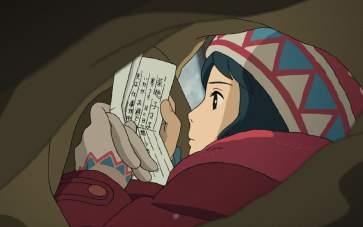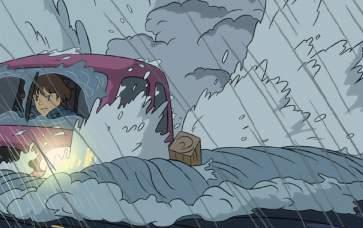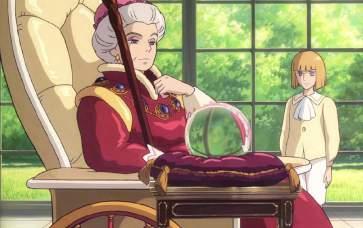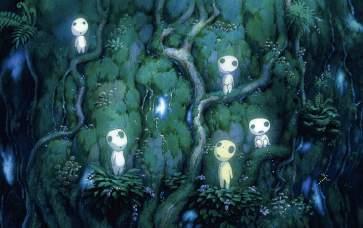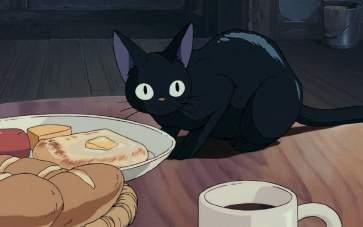






When Ghibli Park, a Studio Ghibli-themed amusement park, opened in November 2022, some visitors were shocked to find none of the usual fixtures associated with amusement parks. The park has no rides, no food stalls and no gift shops — just a few structures scattered throughout the woods on the outskirts of Nagoya, Japan. Ghibli Park’s anti-consumerist bent is befuddling, but only when viewed at face value. When considering who it was built to honor — Hayao Miyazaki, the singular Japanese animator — the design begins to make a lot more sense.
Aside from Walt Disney, Miyazaki is perhaps the greatest animator of all time. Across his storied career, Miyazaki has directed 12 feature films and helped animate tens of others. He made his feature debut

in 1979 with “The Castle of Cagliostro” after spending the earlier part of his career as an in-between artist at Toei Animation. This debut film, about a handsome thief named Lupin who endeavors to free an imprisoned princess and learns about the treasure he seeks in the process, underperformed box office expectations but became a cult hit later on. Despite the initial underwhelming reception, the film’s hilarious and stunning visual imagery set the stage for the success of Miyazaki’s later work by allowing him to hone his artistic vision.
Another benefit came in the form of exposure. Up until “The Castle of Cagliostro,” Miyazaki had spent his entire career as an animator for others. A few years after its release, he and his artistic collaborators were able to build enough momentum to set off on their own, founding Studio Ghibli in June 1985. With newfound creative freedom, Miyazaki put his best foot forward
with the studio’s first film, “Laputa: Castle in the Sky,” in 1986. The story focuses on Sheeta, an orphan girl from another world who falls from the sky, and Pazu, an orphan boy mine worker who finds Sheeta and nurses her back to health. Through the experience, Pazu and Sheeta become friends and then embark on an adventure to help Sheeta reclaim the Laputan throne.
Sheeta was to become the first, but certainly nowhere near the last, of Miyazaki’s strong female characters. His next project, which became the universally celebrated “My Neighbor Totoro” in 1988, spotlighted Satsuki and Mei, the two daughters of a university professor who have journeyed with their father to visit their ailing mother in the countryside. The adults serve as the background to the courageous, vivacious and unstoppable young girls who spend a large part of the film exploring the nearby woods and meeting the forest spirits. Their
GHIBLI-PARK.JP
Dondoko Forest at Ghibli Park contains a wooden structure in the shape of Totoro, one of the studio’s most iconic characters.
beautiful sibling dynamic touches the soul and the joyfulness of their imaginations stays with audiences long after the 86-minute runtime elapses. And of course, pop culture is left with the enduring images of the small, medium and big Totoros as well as the Catbus and soot sprites.
Small inklings of more widespread fame reached Studio Ghibli after “My Neighbor Totoro,” but “Princess Mononoke” in 1997, “Spirited Away” in 2001 and “Ponyo” in 2008 collectively catapulted the independent studio to global powerhouse status. Using this climb, Miyazaki crafted pointed social commentaries about the excesses of consumerism, the importance of environmental conservation and the inconsistencies of orthodoxy. He also made a point of encouraging audiences of all ages around the world to live in harmony with nature and family.
Adored by audiences around the world today who are always all too eager for Studio Ghibli’s next installment, Miyazaki is the visionary of not just one generation, but many generations before and after him in animation. From the painstaking frame-byframe animation process he brought into the limelight to his commitment to art as a vehicle for social and political change, Miyazaki truly epitomizes an auteur fully in his element. How his latest — and possibly last — feature “The Boy and the Heron” performs at this year’s 96th Academy Awards remains to be seen. However, one can be certain that Miyazaki deserves a spot on the Mount Rushmore of all-time filmmaking greats, despite the subtle ambiance of the park that was built to honor him.

ILLUSTRATION BY: ROHINI KUDVA/THE HOYA
Protagonist Masaki Suda encounters a mysterious creature with supernatural abilities in ‘The Boy and the Heron.’
After walking out of the movie theater, the group of friends I went with (knowing I was writing this review) asked everyone’s favorite four-word question after watching a movie, “what did you think?” What was my response to them? “It’s fine, I guess.”
“The Boy and the Heron” is the latest movie by legendary filmmaker Hayao Miyazaki and Studio Ghibli. It follows a boy, Mahito, traumatized by his mother dying in a fire. A few years later, his father gets remarried and uproots the family to a new home. After his stepmother runs away, Mahito follows her into a fantasy world where he has to try and save her — all while he faces the grief of losing his mom.
The setup for Mahito’s character is fantastic. Instead of telling us about Mahito, or having him tell us about himself through

dialogue, the movie shows us that Mahito is brave, smart and resourceful, but still struggles with the trauma and grief of losing his mother. Despite this fantastic introduction, one of the movie’s biggest issues is the lack of a clear motivation for Mahito. We see him go into the fantasy world to save his stepmother — but right before he sets off on his journey, it seems like he laments the fact that she even exists in his life. Mahito, at times, says that he is only going because he thinks his real mother is still alive in that world — but once he gets there, he seems dead set on nothing other than saving his stepmom. This lack of clear motivation makes it hard to decide what we are rooting for Mahito to accomplish.
Furthermore, the stakes felt very low.
I never felt like Mahito was in danger or could fail. From the very beginning, Mahito is clearly clever and courageous, so much so that, whenever he was in a mess, I knew
that he would find a way out of it. The movie never shows him failing in a major way — so I never thought there was a risk of him falling short of his goal (whatever that is), and never doubted that by the end of the movie, he was going to succeed. This heavily diminished the film’s payoff, as it felt like Mahito didn’t overcome anything.
These issues are only exacerbated by the film’s world building. Miyazaki does a great job showing us this beautiful world, but the rules of the universe are never made clear. Anytime Mahito was in danger, it felt like the world would change to ensure he couldn’t lose.
I do want to give credit where it’s due: The themes of trauma, grief, anger, forgiveness and healing in the movie are incredible. “The Boy and the Heron” explores these themes in fascinating and nuanced ways and ultimately has a strong message about grief and the need to overcome it. Though the thematics are rich, however, they can’t
compensate for issues with the characters and world building.
The same goes for the animation in this movie, which is fine. There was never a time when I was blown away by how the movie looked, but it didn’t look bad either.
I have similar thoughts about the animation as I do about the movie as a whole. The character work is serviceable, the plot of the film works — though it’s not the best in Miyazaki’s catalog — and the world-building is okay, still able to create a unique world even if the rules are not clear. Though the themes are rich, they are limited by the issues with their characters and world.
While “The Boy and the Heron” has aspects that die-hard Ghibli fans will enjoy, it leaves a lot to be desired and is a far cry from Miyazaki’s best work. If you love Ghibli movies, then you will like this one. If you are new to Ghibli, maybe start with “Spirited Away” instead.
ILLUSTRATIONS
BY: LAUREN TAO, RACHAEL GROSS, KATHRYN SCHWEICKERT, CLAIRE MIN AND JYOTSNA VENKATESHTHE GUIDE TAKES A STROLL DOWN MEMORY LANE TO EXAMINE FIVE STUDIO GHIBLI FILMS FROM THE PAST FOUR DECADES.

Step into the enchanting world of Japanese animation with the iconic Totoro, a globally renowned symbol that has captured hearts and imaginations worldwide.
“My Neighbor Totoro,” directed by the acclaimed Hayao Miyazaki, is a heartwarming movie that transcends age and enchants audiences with its magical narrative and stunning animation. Originally released in 1988, this Studio Ghibli classic has endured as a timeless tale of childhood innocence, friendship and the wonders of nature.
Set in rural Japan, the plot follows two young sisters, Satsuki and Mei, who move to the countryside with their father to be closer to their ailing mother in the hospital. As they explore their new surroundings, they discover a mystical forest filled with enchanting creatures, most notably the whimsical and iconic Totoro. This oversized, furry forest spirit becomes the girls’ companion, guiding them through their everyday challenges and adventures.
The film’s strength lies in its ability to capture the essence of childhood with authenticity and sincerity. Each character is deeply developed, portraying relatable experiences and resonating with genuine emotions. Satsuki and Mei’s relationship is portrayed with a tenderness that tugs at the heartstrings, evoking empathy and nostalgia for the simplicity of youth. Their mother and father serve as a safe haven and a comforting presence through their open-mindedness and insight.
The animation in “My Neighbor Totoro” is a visual feast, showcasing Studio Ghibli’s unparalleled craftsmanship. Miyazaki’s unique film style of using a watercolor-style approach for the backdrop produces vibrant colors and vivid landscapes that bring the fantastical world to life, creating an immersive experience for the audience. Miyazaki also works to preserve the distinctive Japanese anime tradition by focusing less on the movement of the characters and more on leveraging the setting, not forcing the realism often seen in Western media.
Miyazaki’s storytelling unfolds naturally, emphasizing the beauty of life’s ordinary moments. The film’s animation style and slow nature make the watcher appreciate simple things like a rainy day or walking through a forest. The film imparts valuable lessons about resilience, the importance of imagination and the often-forgotten connections between humans that remind us the world can be soft, not scary.
“My Neighbor Totoro” is a testament to animation’s enduring power. Its universal themes, captivating characters and stunning visuals make it a film that resonates with audiences of all ages. Whether you’re a child discovering the magic of Totoro for the first time or an adult revisiting the film, the enchantment of this Studio Ghibli classic remains as potent as ever.
Amber Cherry Deputy Guide EditorBeloved for their captivating animation and whimsical atmosphere, Studio Ghibli films can rarely be described as “heart-wrenching.” But “Grave of the Fireflies,” the poignant 1988 war drama set against intricate watercolor landscapes of rural Japan, is one notable exception.
Directed by Isao Takahata and based on Akiyuki Nosaka’s short story of the same name, the film takes place in the final months of World War II, where military children Seita (J. Robert Spencer) and Setsuko (Corinne Orr) must suddenly fend for themselves upon their mother’s death in an air raid. As the two grapple with their sudden loss, compounded by the absence of their stationed father, they must also reckon with the poverty, greed and lawlessness that mires a war-torn world.
As is typical of a Studio Ghibli production, the cinematography both stuns and accentuates the emotion brimming behind every scene, starting with the initial air raid on the siblings’ hometown. Within minutes, the crystalline blue backdropping a hand-painted village of thatched-roofed houses is broken by a barrage of industrial gray bombers — leaving a hauntingly beautiful spectacle of red-orange fire and smoke plumes intermingling against a purpling sky.
This dichotomy between tragic and mesmerizing, only accentuated when viewed in tandem, persists throughout the film, with the sandy expanse of beach where the siblings once played suddenly covered in powdery ash on account of overhead fighter jets and the dirty, destitute cave in which they later reside bathed at night in warm, golden firefly light.
Also among the film’s strongest aspects is its writing, as the minimalistic dialogue makes the quiet tragedy leap meaningfully to life on-screen. For example, the air raids that become routine throughout the movie are punctuated only by the occasional “You’re not afraid, are you?” or “Is it okay?” exchanged between the siblings, underscoring their deep mutual affection through the most difficult times. Setsuko’s childlike innocence especially deepens the sorrow inherent in their situation, especially as she buries a mound of firefly carcasses — as families do for their fallen — while exclaiming, “Why must fireflies die so young?” in one harrowing scene.
“Grave of the Fireflies” is a carefully-paced, visually-impressive and courageous feat of storytelling that leverages a conflict commonly perceived as a dark mark on Japanese history with immense profundity in its 90-minute runtime. Although emotional nuance was arguably lost in adapting Nosaka’s story for the big screen, it packs a cinematic punch that easily renders it one of the best war movies all the same.

A HEART-WRENCHING TALE


Caroline Woodward
Special to The Hoya
“Spirited Away” exemplifies director Hayao Miyazaki’s unique style of storytelling through fantastical, bizarre worldbuilding, complex yet understandable characters and a message that transcends time even 23 years after the movie’s release.
The film begins with the protagonist, Chihiro (Daveigh Chase), who moves to a new town, clearly upset with her situation. During the car ride, her parents turn down the wrong road and stumble upon what looks to be an abandoned theme park, which they insist on exploring despite Chihiro’s reservations. While walking around, they discover a stall with delicious-looking food, which the parents immediately begin to indulge in. Chihiro’s caution proves correct as her parents begin to transform into pigs while ghostly figures emerge from around the park, some of which take her parents away. Without getting into any more spoilers, Chiriho must face various trials in this otherworldly environment to get her parents back and, hopefully, escape.
This is, admittedly, a wild premise. Chihiro, and by extension, the audience, has no idea what is going on, and the film never goes out of its way to explain itself. We are forced to learn alongside Chihiro purely through context and our assumptions, mirroring her journey of growth and discovery. Chihiro, and the audience, start out alone. Yet, as the story progresses and Chihiro continues to navigate, discover and even befriend the inhabitants of this spirit world, a sense of profound nostalgia and magic begins to drive the narrative. Chihiro and the audience have been here before. Beautiful, luscious animation and incredible scoring by Ghibli staple Joe Hisaishi aid this odd familiarity.
This icon of Studio Ghibli’s catalog has been highly praised over the years, receiving various accolades, including the 2003 Oscar for Best Animated Feature. It remains a preeminent force of animated filmmaking that not only holds up but continues to take on new meaning, dealing with themes of growing up, identity, loss, consumerism and environmentalism.
“Spirited Away” is a coming-of-age story. It is an underworld narrative like no other. It is a children’s film for all ages. It is endlessly rewatchable and utterly moving, a feast for both the eyes and the soul. Above all though, I consider “Spirited Away” to be the crowning achievement of Studio Ghibli’s rich catalog and a must-watch for anyone who has ever felt alone, had to grow up, or simply wants to watch a truly special movie (i.e. literally everyone).
Tanvi Gorripati Hoya Staff Writer“Howl’s Moving Castle” is a stunning film with gorgeous animation and a recognizable, sweeping score. However, the film disappoints in its writing, despite creating lovable and multi-faceted characters.
“Howl’s Moving Castle” tells the story of Sophie (Jean Simmons), an old-soul hat maker, who gets thrust into the middle of a war with a handsome wizard, Howl (Christian Bale), after getting cursed by the Witch of the Waste (Lauren Bacall). Like many other Hayao Miyazaki creations, a story of magic and whimsy is undercut by the devastating effects of a pointless war. The movie opens with a view of the titular residence, an eccentric hodgepodge of many metal rooms revealed to be held together by a fire demon named Calcifer (Billy Crystal).
Sophie is a character you continue to root for throughout the film. Her relationships with the other inhabitants of the castle are the highlight of the movie. The moving castle becomes a place that welcomes all of the misfits, creating a dysfunctional family where everyone is accepted, from a cursed scarecrow to a disgraced witch. The family scenes are heartwarming and are easily the best part of the film.
But unlike other Studio Ghibli films, the writing in “Howl’s Moving Castle” falls flat. The film tries to juggle two different stories at once: Sophie’s development and the devastating war. It is largely unsuccessful, as it spends too little time on either aspect to fully delve into the social commentary being made. From wizards and witches giving their souls up for the fight to civilians being bombed as a proxy for the government, Miyazaki makes a halfhearted point about the horrors of a war being fought for no reason. However, the message is too underdeveloped to make an impact.
The film seems incomplete. The romance between Sophie and Howl, despite their scenes together being touching, blossoms from out of nowhere. The Witch of the Waste is treated with respect and kindness after her transformation into a mundane elderly woman, her decades of evil actions simply forgotten. The devastating and violent war is called off as soon as Howl’s character transformation is completed. Many of the characters function solely as plot devices to further Howl’s development, making the conclusion of the film seem rushed with too many loose ends.
While the film falls flat in writing and pacing, Miyazaki continues to excel in visuals and cinematography. Overall, the film is enjoyable if one can appreciate the animation and the music while ignoring the many issues in the plot.
‘PORCO ROSSO’ AN UNDERRATED GEM
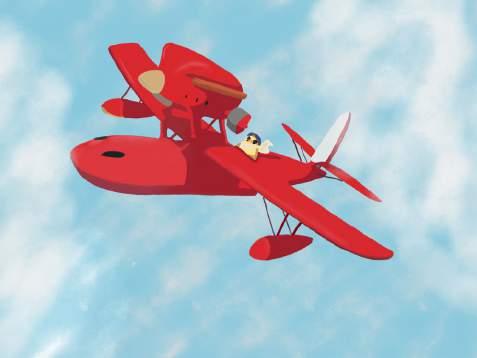

“A pig that doesn’t fly is just a pig.” That’s Marco — the main character of Hayao Miyazaki’s 1992 film “Porco Rosso” — a fighter ace and former World War I pilot, trapped in a porcine body after a mysterious curse, who haunts the Sicilian skies as a bounty hunter.
At face value, he’s right. If he were confined to a pen rather than his sleek red aeroplane, Marco would be “just” a pig. But it’s more than that. In “Porco Rosso,” flight is as much a prison as the titular airman’s condition, constantly reminding Marco of the brutality of his wartime experiences and the humanity that he has lost along the way.
Without his plane, Marco would be grounded, unexceptional — but with it, he is irrevocably changed, altered by combat in a way that necessitates he return again and again to the cockpit, just to maintain some semblance of himself. This Catch-22 is at the heart of what makes “Porco Rosso” great, allowing Miyazaki to work his magic to elevate a simple children’s tale into the realm of real, existential significance.
But of course, Miyazaki also gets some help from a spectacular ensemble cast. Studio Ghibli has a rich tradition of attracting the best of the best for their English dubs (see Robert Pattinson’s terrific performance in “The Boy and the Heron”) — “Porco Rosso” is no different. Michael Keaton perfectly embodies Marco’s gruff bravado, while Susan Egan is the perfect fit for Gina, Marco’s gentle, forlorn love interest. Toss in braggadocious American pilot Donald Curtis (Cary Elwes) and precocious mechanic Fio (Kimberly Williams-Paisley), and there is nary a weak link in “Porco Rosso’s” acting department.
The score, too, is sneakily among Ghibli’s best. Granted, it doesn’t have the iconic tracks of “Spirited Away” or “My Neighbor Totoro” (e.g., “The Name of Life” or “The Wind Forest” respectively), but longtime Ghibli composer Joe Hisaishi crafts a thematic soundscape that fits “Porco Rosso” like a glove — at times spritely and adventurous, at others somber and meditative.
So if you decide to celebrate this Guide special issue with a Miyazaki marathon (which I would highly encourage you to do), be sure to add “Porco Rosso” to the queue. It may not be the first option that springs to mind when one thinks “Ghibli,” but I assure you it is well worth a viewing.


is a Multilayered,
Pria Gadkari
Special to The Hoya
Whether you are a die-hard Hayao Miyazaki fan or new to the genre of anime, Studio Ghibli’s “Princess Mononoke” has something for everyone. From stunning visuals to action-packed sequences and a timeless environmental message, there is much to love in this animated masterpiece.
First released in Japan in 1997, “Princess Mononoke” was a smash hit, breaking box office records and grossing just under $160 million in eight months. In 1999, the movie was released in the United States with English voice-overs for characters including the kindhearted Ashitaka (Billy Crudup), mysterious San/Princess Mononoke (Claire Danes), sleazy Jigo (Billy Bob Thornton), commanding Lady Eboshi (Minnie Driver) and hilarious Toki (Jada Pinkett Smith). Though the English

audio version did not quite garner the same success as in Japan, it received glowing reviews and favorable DVD sales. It was the U.S. release of “Princess Mononoke” that catapulted Studio Ghibli onto the international stage.
“Princess Mononoke” begins with an epic fight scene between Ashitaka, the last Emishi prince, and a demon boar god, later revealed to be named Nago. While Ashitaka successfully manages to kill the demon, he sustains a serious wound which the town wise woman tells him is cursed and deadly. In search of a cure, Ashitaka embarks on a journey to find the “spirit of the forest,” encountering the clashing forces of Iron Town, led by Lady Eboshi, who wishes to expand the iron operation further into the forest, and the goddess Moro’s pack of wolves determined to protect it.
As Ashitaka immerses himself deeper into the conflict, he befriends San, also known as
Princess Mononoke, a human raised by the wolves who is filled with hatred for Lady Eboshi and the citizens of Iron Town for the destruction they have caused to the forest. Ashitaka, who intends to see the world with “eyes unclouded by hate,” finds himself torn between two worlds — nature and civilization — as he tries to find a way to bring peace.
Part of what makes this story so compelling is the depth of its characters. Though there are plenty of clashes, there is no clear villain. For example, the boar god that attacks Ashitaka was once a benevolent protector of the forest before an iron bullet turned him evil. Lady Eboshi is also neither a saint nor completely rotten. While she does wage war against the forest gods, it is what she thinks she must do to support her town of misfits. Even San, who is initially hostile to Ashitaka and resents him for preventing her attack on Lady Eboshi, eventually works with him to
ILLUSTRATION BY: KATHRYN SCHWEICKERT/THE HOYAAs a result of being raised by the wolf goddess Moro, San has a fierce affinity for the forest and its inhabitants in ‘Princess Mononoke.’
protect the forest spirit and reconcile with Iron Town. There are also nuggets of humor sprinkled throughout the film, most notably from the headstrong Toki, who pokes fun at just about everyone.
By positioning “Iron Town” and “forest spirits” against one another, the creators of “Princess Mononoke” weave in not-so-subtle themes of environmental conservation and the destructive tendencies of civilization. Still, the film provides many important insights into environmental issues and illustrates the difficulties of balancing human progress with conservation while emphasizing the importance of both.
After all this, if you find yourself uninterested by the fanciful plot, consider watching for the stunning visuals alone. When you think of animation, perhaps you picture the pinwheel-esque running cycles of Mickey Mouse cartoons or the 3D animation of “Despicable Me.” While these movies certainly have some charm, Hayao Miyazaki brings animation to a whole other level. What makes every Studio Ghibli anime so incredible is the meticulous attention to detail in every landscape, character movement and gust of wind. Backgrounds are hand-painted with poster color — a medium similar to watercolor — creating perfect depth, realism and beauty where characters can come alive.
The many layers of the “Princess Mononoke” animation can be seen from the very beginning. As Ashitaka fights Nago, the boar is covered in writhing worm-like demons as it barrels after Ashitaka amidst a luscious green meadow, leaving a trail of rotten earth behind him. The film cuts and zooms like one would expect from any action movie, making it almost impossible to not become completely immersed in the majestic world emanating from the screen.
“Princess Mononoke” is a rare gem of a film that manages to seamlessly weave together enthralling action sequences, enchanting characters and environmental activism into one fantastical story. Expect nothing short of magic from the incredible Hayao Miyazaki and Studio Ghibli.
 Preston Shirazi Guide Columnist
Preston Shirazi Guide Columnist
In an era dominated by Disney animations, very few studios have been able to break into watchers’ hearts and create a creative world of their own. Studio Ghibli stands as a beacon of creativity in this era, weaving narratives that transcend borders and captivate hearts. But what sets Ghibli apart from the cinematic landscape, and why does its magic endure amidst the churn of modern entertainment?
Since its inception in 1985 with the release of “Laputa: Castle in the Sky,” Studio Ghibli has been synonymous with artistic excellence. Its founders, Hayao Miyazaki and Isao Takahata, embarked on a journey to redefine Japanese animation, drawing inspiration from both Eastern and Western cultures. While their early works paid homage to Japanese folklore and manga, Ghibli’s foray into adapting Western stories signaled a new chapter in its illustrious legacy. The transition was subtle yet profound, with films like “Howl’s Moving Castle” and “Tales from Earthsea” embracing narratives from British authors Diana Wynne Jones and Ursula K. Le Guin, respectively. Miyazaki’s
visionary storytelling breathed new life into these tales, infusing them with themes of environmentalism and feminism and the whimsical spirit that defines Ghibli’s ethos. Central to Ghibli’s allure are its relatable characters, especially its female protagonists. From the spirited Kiki in “Kiki’s Delivery Service” to the courageous San in “Princess Mononoke,” Ghibli celebrates the ordinary in extraordinary ways. These characters embody the essence of Ghibli’s storytelling — flawed yet resilient, ordinary yet extraordinary. One of the very things that they embrace in their stories that other studios shy away from is the cost for the protagonists and heroes to achieve their goals. In the recent “The Boy and the Heron,” Mahito is not given the magical ending that you’d expect in a Disney film. Despite the magical world he finds himself in, and the superhuman world-building power he is offered, he finds solace without magic. He accepts the losses in his life and realizes that there will be times when he has no control, and that he must appreciate what he has in the present to honor the past. Ghibli incorporates magic into the plot in a way that enhances the narrative but never sets things straight. At the end of the day, Ghibli films emphasize the strength of the individual and the human ability to overcome hardships.
Ghibli’s success is not just attributed to its narrative prowess; it’s a testament to its meticulous craftsmanship. Miyazaki, a traditionalist at heart, eschews computer-
generated imagery in favor of hand-drawn cel animation, a process in which transparent sheets are painted on and superimposed to create a rich and engaging scene, preserving the art form’s integrity in a digital age. While not necessarily better than computergenerated animation, it is just one of the many ways in which there seems to be a legitimate effort on the part of Miyazaki and Studio Ghibli to create a connection with their art, investing in every shot. His attention to detail is legendary, with every frame meticulously curated to evoke emotion and wonder. As a viewer, every frame is captivating and organic, with a sense of wonder that can only be attributed to the magic of Ghibli. In an industry plagued by formulaic plots and computer-generated imagery (CGI) extravaganzas, Miyazaki’s filmmaking ethos resonates deeply. He rejects the notion of cinema as mere entertainment, instead championing films that inspire, educate and stir the soul. For Miyazaki, each movie is a canvas, a medium through which he imparts timeless messages of resilience, empathy and the beauty of the human spirit.
But Ghibli’s appeal extends beyond its visual aesthetics. At its core, Ghibli is in the business of storytelling, weaving narratives that resonate with the human experience. Whether it’s the whimsical adventures of “My Neighbor Totoro” or the epic journey of “Princess Mononoke,” Ghibli’s films are imbued with universal themes of love, loss
ACROSS
1. Miyazaki’s home country
5. ____POP: A New Kind Of Soda brand
6. Key instrument for EDM and techno music
8. Miyazaki’s first name
9. ____ in (Inducted into office)
DOWN
1. Hutcherson, Groban and Brolin
2. Sosuke’s fish friend and Miyazaki’s tenth film
3. Where to say “I do”
4. 1-Across in 1-Across
and redemption. Moreover, Ghibli’s refusal to adhere to conventional tropes sets it apart from its contemporaries. Miyazaki’s rejection of formulaic storytelling is proof of his belief in the power of creativity and originality.
At the heart of Ghibli’s success lies its refusal to conform to industry norms. Miyazaki, a staunch advocate for artistic freedom, shuns conventional scriptwriting, preferring to let stories unfold organically. His collaborative approach empowers artists to breathe life into his visions, resulting in films that are as visually stunning as they are narratively rich.
In a world where streaming platforms dominate the entertainment landscape, Ghibli’s commitment to the theatrical experience is a welcome respite. While digital platforms offer convenience and accessibility, there’s something inherently magical about the communal experience of watching a Ghibli film in a darkened theater. As we navigate through an increasingly homogenized cinematic landscape, Studio Ghibli serves as a reminder of the transformative power of storytelling. Its films are not just entertainment; they’re an invitation to explore the boundless realms of imagination and wonder. In an age where creativity is often sacrificed at the altar of commercialization, Ghibli stands as a beacon of hope, inspiring audiences to demand more from the entertainment industry. For in the end, it’s not just about the films we watch, but the stories we carry
ACROSS
1. Popular Southern dish
6. Totally tubular
7. The end of a shoelace
9. Key and ____
10. You get these kinds of messages when you have a hold on your registration.
DOWN
1. A fruit that always slaps at Epi’s
2. A party typically thrown without parental supervision
3. A habitually lazy person
5. What Grover is in the Percy Jackson series (alternate spelling)
8. English rock band who sang Mr. Blue Sky

Jasmine Criqui Senior Guide Editor
Acclaimed Japanese animator Hayao Miyazaki has directed 10 of Studio Ghibli’s 24 feature films. In honor of The Guide’s Special Issue, can you match all 10 titles to stills from the movie?
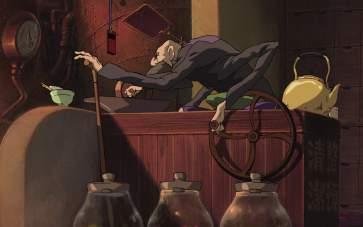

1. Castle in the Sky (1986)
2. My Neighbor Totoro (1988)
3. Kiki’s Delivery Service (1989)
4. Porco Rosso (1992)
5. Princess Mononoke (1997)
6. Spirited Away (2001)
7. Howl’s Moving Castle (2004)
8. Ponyo (2008)
9. The Wind Rises (2013)
10. The Boy and the Heron (2023)

